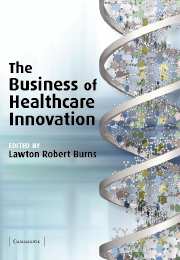Book contents
- Frontmatter
- Contents
- List of figures
- List of contributors
- Preface
- Acknowledgments
- 1 The business of healthcare innovation in the Wharton School curriculum
- Part I The life sciences
- 2 The pharmaceutical sector
- 3 The biotechnology sector – therapeutics
- 4 Biotechnology business and revenue models: the dynamic of technological evolution and capital market ingenuity
- 5 Mergers, acquisitions, and the advantages of scale in the pharmaceutical sector
- Part II Devices and information technologies
- Index
4 - Biotechnology business and revenue models: the dynamic of technological evolution and capital market ingenuity
Published online by Cambridge University Press: 22 September 2009
- Frontmatter
- Contents
- List of figures
- List of contributors
- Preface
- Acknowledgments
- 1 The business of healthcare innovation in the Wharton School curriculum
- Part I The life sciences
- 2 The pharmaceutical sector
- 3 The biotechnology sector – therapeutics
- 4 Biotechnology business and revenue models: the dynamic of technological evolution and capital market ingenuity
- 5 Mergers, acquisitions, and the advantages of scale in the pharmaceutical sector
- Part II Devices and information technologies
- Index
Summary
Overview
The biotechnology sector has held great promise for the alleviation of human suffering through the creation of novel protein-based drugs or drugs that mimic natural proteins. In like manner, biotechnology promises to expand the food supply with the modification of plants and animals. Biotechnology is also involved in environmental remediation and other industrial processes. During its march from origination to the present day the industry has encountered changes in social expectations and business conditions that have been far more volatile than anticipated, and this has required an agility in reconfiguring scientific, business, and financing strategy. Biotechnology companies have had to respond in kind to challenges such as:
proving their own technologies on the complex path of preclinical research and clinical development
navigating through an ever-expanding and evolving corpus of science and the related global base of intellectual property owned by disparate, unrelated entities, each with economic objectives of their own
compensating for an ever-expanding competitive environment
adapting to a regulatory process that was itself evolving to accommodate the changing nature of the technology
responding to the volatility (and often a loss of confidence) of the capital markets
reconfiguring relationships with initially enthusiastic but ultimately reticent pharmaceutical company partners, who were at the same time responding to these same challenges affecting their internal biotechnology programs, further compounded by a nonproductive research pipeline and a portfolio of expiring patents, all within the midst of massive pharmaceutical industry consolidation (see chapter 2)
The above challenges induced a wholesale rethinking of the biotechnology and pharmaceutical value chain, and consequently of the industry's business models.
- Type
- Chapter
- Information
- The Business of Healthcare Innovation , pp. 190 - 222Publisher: Cambridge University PressPrint publication year: 2005
- 3
- Cited by

